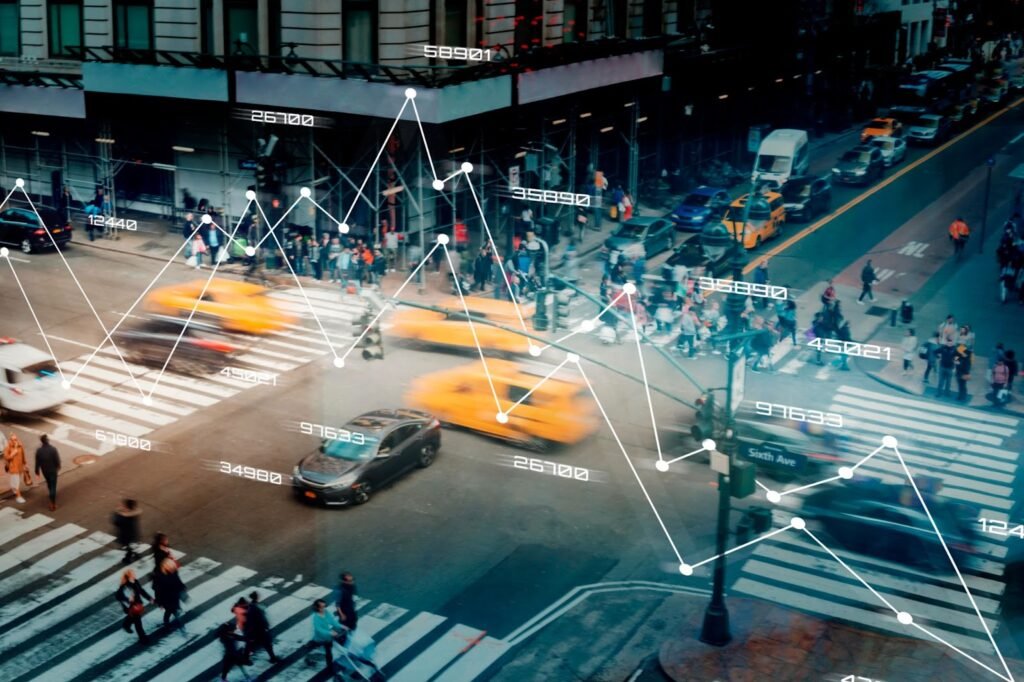We continue our series in yet another sector — transportation. Artificial intelligence could transform the realm of transport, and we will cover some of its capabilities in this article. Artificial intelligence is the ability of computers to learn and adapt like humans by finding patterns and adjusting to new information, called machine learning. This technology increases the efficiency and even the accuracy of task performance. As transportation is affected by various external factors that determine its efficiency and the overall safety of all its users, implementing artificial intelligence into this industry brings many benefits. Artificial intelligence can use computer vision services, which include object detection, video recognition, and object tracking, to monitor the roads and combat common human reactions and accidents. AI may be able to monitor vehicle performance to predict repair locations or optimize traffic flow in a congested intersection. This technology, however, does bring liability issues and security risks along for the ride.
Autonomous Vehicles
One of the most widely known forms of artificial intelligence in transportation is the notion of autonomous vehicles. This technology depends on computer vision, which uses AV cameras that interpret data to identify patterns through machine learning, allowing the system to recognize curbs, pedestrians, street signs, and traffic lights. For example, the Google Waymo vehicle uses various sensors on its roof and left rear wheel to create a dynamic 3D map of its environment. It also has a radar system on its bumpers to calculate its relative distance from potential obstacles. These are examples of features that attempt to make a vehicle almost entirely autonomous. However, this level of technology is still developing with hopes of artificial intelligence further reducing human error and decreasing safety violations. At a lower level, some autonomous features in newer cars still require the driver to pay attention. These include hands-free steering, which centers the automobile, and adaptive cruise control, which maintains a safe distance between the car in front. These are known as driver assistance systems.
Traffic and Routes
AI can also manage traffic by having the system predict congestion and design traffic systems that can improve traffic flow. Attaching AI software to traffic lights creates “smart” traffic lights that switch colors based on the direction and volume of traffic arriving from each lane. It can also optimize travel routes for freight vehicles, like trucks, providing them with the most cost-effective and efficient passages. Predictive AI can also be implemented inside vehicles through predictive maintenance, in which machine learning algorithms analyze data gathered by sensors around a car and predict when and where vehicle maintenance is needed. This system can increase efficiency on the road and in the air, as airlines could make use of the system to decrease aircraft downtime and maintenance errors. The efficiency and accuracy of artificial intelligence indeed have the potential to save us time, money, and lives.
Potential Risks
However, some negative implications of artificial intelligence in transportation shouldn’t be overlooked. We must consider system failures, which may lead to the malfunctioning of many autonomous systems, which could lead to the vehicles themselves malfunctions and create severe damage. They may even cause entire departments of transportation to become delayed due to a network error. On top of this, there is the question of liability. If an issue were to occur due to an autonomous vehicle, who would be liable for the damages if there is no driver? There are also issues regarding the safety of data collected by these systems, which are susceptible to virtual hijacking or data breaching, creating severe problems and sensitive data loss. As this technology continues to grow and advance, we hope that there will be other technologies evolving with it to address these liabilities.
With its predictive capabilities, sensors, and computer vision systems, artificial intelligence in the transportation industry holds the potential to increase efficiency and be a significant technological success. However, the longevity of this success is dependent on the strength of the negative implications that come with it.
Works Cited
“Artificial Intelligence (AI) In The Transportation Industry: Potential New Risks”. Usrisk.Com, 2023, https://www.usrisk.com/about-us-risk/news-and-articles-all/4-19-21-artificial-intelligence-in-the-transportation-industry-potential-new-risks/. Accessed 14 Aug 2023.
“Artificial Intelligence (AI): What It Is And Why It Matters”. Sas.Com, 2023, https://www.sas.com/en_us/insights/analytics/what-is-artificial-intelligence.html. Accessed 4 Sept 2023.
Bowman, Jeremy. “The Future Of Logistics: How AI Is Changing The Transportation Industry | The Motley Fool”. The Motley Fool, 2023, https://www.fool.com/investing/2023/06/02/future-of-logistics-how-ai-is-changing-transport/. Accessed 14 Aug 2023.
Kolesnikova, Irina. “How AI In Transportation Can Improve Our Everyday Lives”. Mindtitan, 2023, https://mindtitan.com/resources/blog/ai-in-transportation/. Accessed 14 Aug 2023.
“The Future Impact Of AI On The Transportation Industry: Advancements And Potential Applications”. Linkedin.Com, 2023, https://www.linkedin.com/pulse/future-impact-ai-transportation-industry-advancements-nishant-singh. Accessed 4 Sept 2023.
“What Are Self-Driving Cars And How Do They Work?”. Enterprise AI, 2023, https://www.techtarget.com/searchenterpriseai/definition/driverless-car. Accessed 4 Sept 2023.
